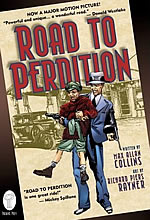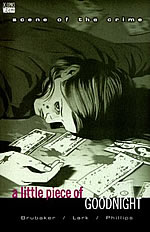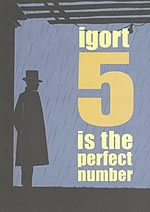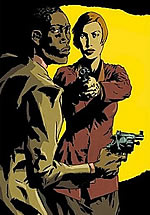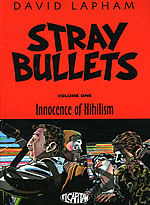Crime Comics:
The Many Colours Of Noir
"Whichever way you turn, fate sticks out its foot to trip you." That was how American director Edward G. Ulmer described the mood of doom in his B-movie, a style that French critics in 1946 dubbed ‘noir’.
Black contains every colour and noir spans a whole spectrum of styles and stories, from detective mysteries to true crime biographies, from police procedurals to gritty urban tragedies. Right now, some of the hottest selling noir graphic novels flying off the shelves are Dark Horse’s new compact, manga-sized, Chip Kidd-repackaged editions of Frank Miller’s Sin City. Riding on the back of the movie’s smash success, people are discovering the original comics that served as its virtual storyboard and digital set designs.
Now that ‘civilians’ are experiencing just how powerfully the graphic novel medium can serve up some of the hardest of hard-boiled crime fiction, it’s good timing to survey some of the history and the other shining examples of the many colours of noir. Like gangster tale Road To Perdition, Sin City is yet another wake-up call to the book-buying public that comics, and the comic-based movies, are not solely about superheroes. Actually crime comics were once one of the most popular, and most controversial, genres of American comic books.
Progressive publisher Lev Gleason took on the idea of Crime Does Not Pay, the first no-holds-barred ‘true crime’ comic book, from associates and co-editors Charles Biro and Bob Wood in 1942. Unusually, Gleason cut a deal with them, offering a profit-share and total editorial freedom. For all involved, it proved that crime definitely did pay, and in spades.
Hosted by the spectral Mr Crime in moustache and top hat, the brutal tragedies of real criminals were recounted in dense, enthralling detail, always ending with the comic’s dire warning to underline the supposed moral message.
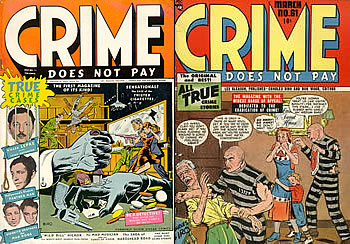
Soon Biro’s lurid covers of their Crime Does Not Pay were shouting "More Than 6,000,000 Readers Monthly!" Those figures did not represent actual copies sold, but multiplied the number of pass-along readers of each copy. Still, it was probably a realistic estimate of the title’s massive audience, a market no shrewd publisher could ignore. EC’s Bill Gaines reckoned that Biro and Wood’s monthly was selling four million copies an issue at its peak in the late Forties.
Legend has it that Stan Lee used to phone Biro up and ask, "What’s the secret Charlie?" Biro never told him, but he’d tell his colleagues, "There’s no secret. The secret is Charles Biro."
Between 1947 and 1951, there was a short but significant crime comics spree, when the genre’s market percentage jumped into double figures, as high as 14% in 1948. But they soon became the scapegoats of the anti-comics campaigners.
After 1955 and the enforcement of the Comics Code’s tight controls on violence and specific restraint on using the word ‘crime’ prominently on any cover, the genre withered away, basically disappearing during the whole of the Sixties and beyond. Gil Kane’s Savage and Jack Kirby’s In The Days Of The Mob magazines both died after one issue. Steranko’s ‘visual novel’ Chandler in 1976 was another lone attempt.
Ever since he discovered the bruising prose of former comics scribe Mickey Spillane at the age of 13, Frank Miller had been creating crime strips of his own, essentially naive attempts at what would mature into Sin City. But back in the Seventies he found no takers. When he tried breaking into comics, the only game in town was "men in tights." It was only after the massive success of Dark Knight Returns, a noir Batman, that Miller was given carte blanche to unleash his black-and-white dramas of "knights in dirty armour", which deserve much of the credit for the Nineties crime comics revival.
It is no accident that, in his wake, several of America’s finest young writers, like Bendis, Azzarrello, Brubaker and Rucka, are also passionate about noir and detective fiction.
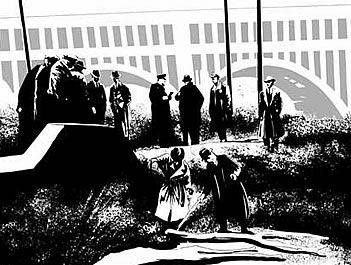
For me, one of Bendis’ best graphic novels is one of his earliest, Torso, from Image. In 1935, lawman Eliot Ness, the ‘Untouchable’ who put away
Capone and the Mob, is eager to pursue his fame and political ambitions as Cleveland’s new Safety Director. When a string of mutilated bodies point to America’s first serial killer, Ness vows to catch the ‘Torso Killer’. His failure to do so thwarts his career. For the true story co-written with Marc Andreyko, Brian Michael Bendis uses photo collage and stark graphics to recreate this thoroughly researched Thirties case.
Among the most intelligent detective investigators in recent graphic novels must be Scene Of The Crime by Ed Brubaker, drawn by Michael Lark and Sean Phillips. It had me hooked from the first cliffhanger when it was serialised in 1999 in four issues from Vertigo.
On the mean streets of San Francisco, young Jack Herriman is not your typical hard-boiled private eye. When he was 12, he was damaged physically and psychologically from witnessing a car bomb that mistakenly claimed the life of his cop father. The explosion also cost him his left eye. Raised by his Uncle Knut, a famous crime-scene photographer, Jack grew up drowning himself in drink and drugs and wrecking a romantic relationship. Now he is trying to rebuild his life as a detective who refuses to carry a gun. A case comes his way from his father’s ex-partner Paul Raymonds. Jack is hired by Alexandra Jordan, a woman he realises is Raymonds’ mistress, to find her missing sister Maggie. Jack may think that he has solved this missing-person case when he finds her, but by next morning she is dead.
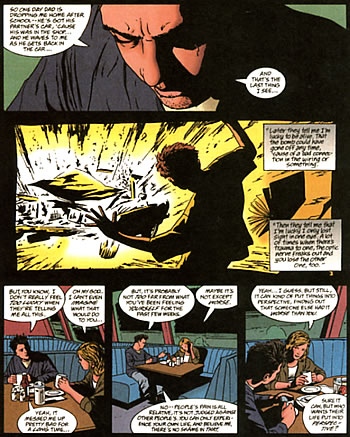
Brubaker has said that the inspiration for his plot came from the lives of two sisters he knew when he was in his late teens. He writes that Maggie just wanted, "a little piece of goodnight" she had never known as a child; he makes this the book’s tender subtitle. While there man be no escape from the damaging mistakes of the past, Brubaker shows how denying them and covering them up drag the Jordan family down even further, and how facing up to them lets Jack start to heal from years of self-torture. I for one still hope Herriman will get more mysteries to solve in the future.
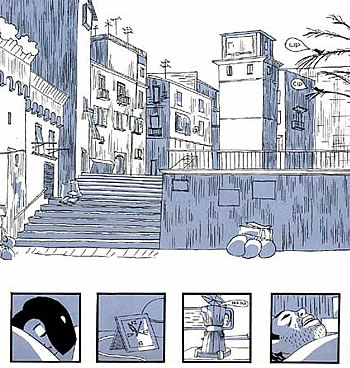
Recently, the Europeans have also served up some strong stories of period noir. For example, 5 Is The Perfect Number by the Italian Igort from Cape tells the story of Peppino, an old-fashioned Mafioso, who is forced out of retirement after his son is murdered by a contract killer disguised as a street mystic. Betrayed by his own Mafia gang, Peppino learns that the old rules no longer apply and kills his former boss. Igort’s two-tone elegance evokes his native Sixties Italy in a tale of one man’s need for redemption.
Subtitled Better Living Through Crime, the Miss paperback from DC/Humanoids collects the quartet of gritty French albums by writer Philippe Thirault and artists Marc Riou and Mark Vigouroux. The seedy underbelly of New York’s roaring Twenties brings together expelled convent girl ‘Miss’ Nola and former Harlem pimp Slim. When their luck and cash run dry, they hook up as guns for hire. Survival may be more important to them than scruples, but their unusual partnership means that they wind up looking out for each other and slowly, warily, falling in love.
Crime comics are back with a vengeance and a variety never seen before, from David Lapham‘s heart-breaking Stray Bullets to Paul Grist‘s mickey-taking Kane.
Frankly, it would be an absolute crime to ignore them.
Posted: September 10, 2006The original version of this article appeared in 2004 in Comics International, the UK’s leading magazine about comics, graphic novels and manga.














